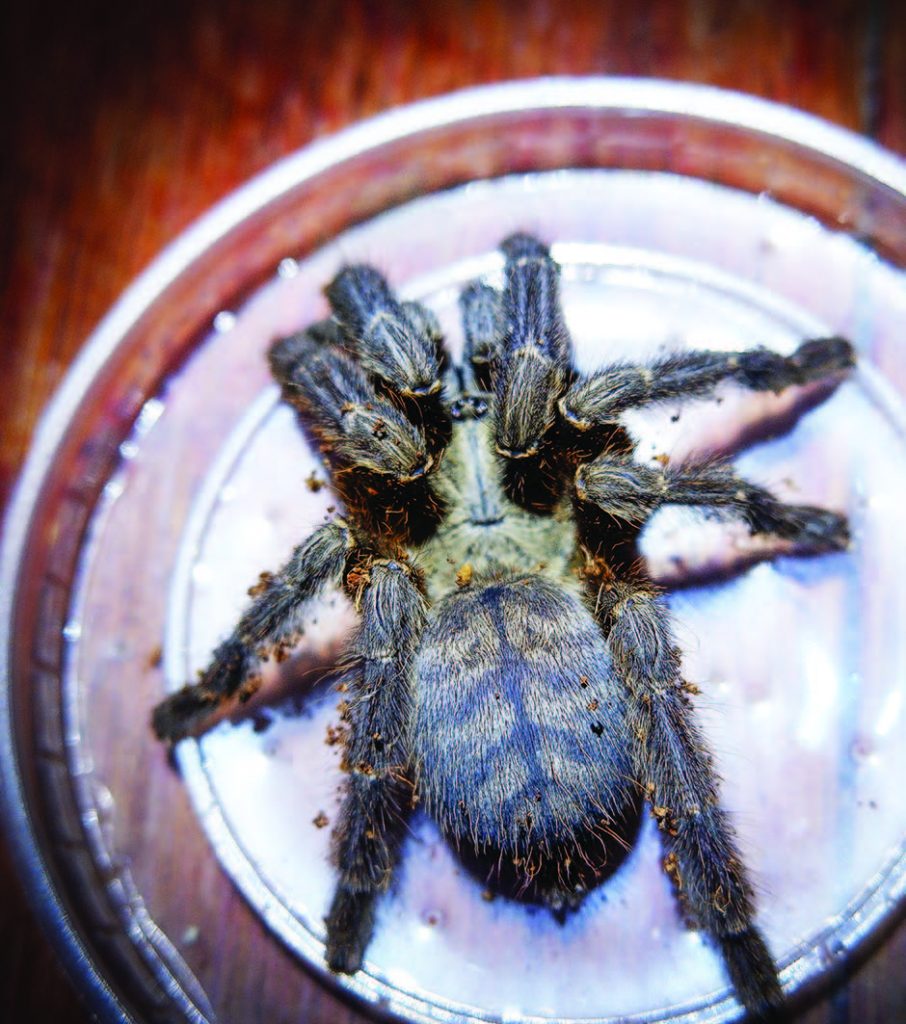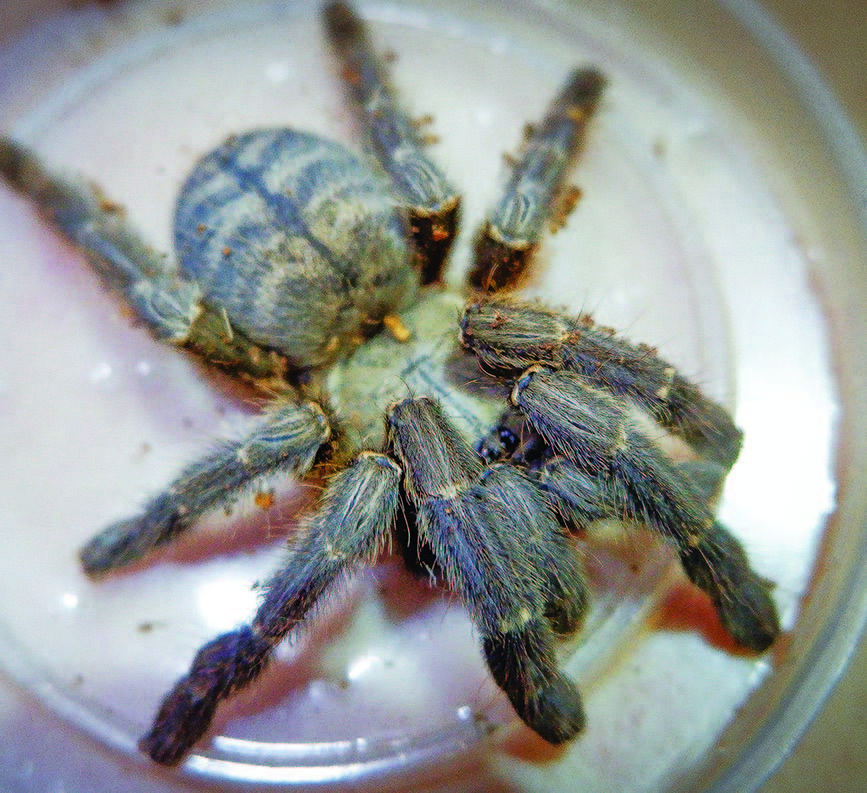The Philippines has a wide variety of endemic species, including several tarantula species. Three Philippine Earth Tiger Tarantulas are currently being classified based on where they were initially found. Since these tarantulas have yet to be completely described by taxonomists, they are labeled as central, oriental, or south, pertaining to the different regions in Mindanao.
They vary in color and size. Those from South Mindanao are generally smaller, and their colors are slightly more vibrant.
Behavior and temperament
The Philippine Earth Tiger from South Mindanao is an arboreal tarantula, so they often reside in shrubs and can also be found in hollowed trees. Oftentimes, people spot them in areas being developed into subdivisions or industrial areas.

Scientific publications have recorded little information about their habits. Most information about the Philippine Earth Tiger comes from exotic pet keepers and hobbyists who house them in captivity.
When threatened, these tarantulas turn skittish and would prefer to run away from potential predators than defend themselves. There are still no recorded bite incidents from Philippine Earth Tigers, so information about their venom is currently unknown.
Philippine Earth Tigers are quite shy. They prefer to build heavy webs as they hide high up in trees or in tight spaces between trunks. Without trees for shelter, they tend to make heavily webbed tunnels and burrows for shelter.
Diet
Philippine Earth Tigers from South Mindanao primarily feeds on insects and other smaller animals. Their venom is potent enough to kill prey, helping them hunt effectively. Since they are ambush predators, they usually wait for prey to be within strike range before going for the kill.
They do not grow very large, so their potential prey must be smaller or only slightly larger than them.
In captivity, these tarantulas often feed on captive-bred crickets, worms, roaches, and other prey insects.
Question and Answer
Since there is currently very limited information about the Philippine Earth Tiger from South Mindanao, Animal Scene sat down with Kael Dela Cruz of Gorby Exotics, who has firsthand experience in keeping these tarantulas.
Q: WHAT MADE YOU INTERESTED IN PHILIPPINE TARANTULA SPECIES?
Kael Dela Cruz: [It’s] because of their natural beauty, [and the fact that the species lacks the attention it needs to be studied adequately]. . . I’m [taking care of] almost all available Earth Tiger species in the market.
They are one of my personal favorites. I know in the future that they can represent our country and make us really proud. As early as now, I personally call them “The Philippine Big 3” (sp. South, sp. Central, sp. Oriental).
Q: WHAT MADE YOU INTERESTED IN PHILIPPINE EARTH TIGERS FROM SOUTH MINDANAO SPECIFICALLY?

The sp. South Mindanao is the smaller Earth Tiger species in our country, making them more visible locally. I [acquired] some sling from a local breeder and raised them until maturity. That gave me a chance to observe how they adapt in captivity and study their behavior.
Q: HOW DIFFERENT IS THIS SPECIES COMPARED TO THE OTHER PHILIPPINE EARTH TIGERS?
They are the smallest compared to other Philippine Earth Tigers. They can grow up to 3 to 4 inches. An adult female is now at exactly 3.5 inches and [would not grow beyond that] even after a molt. Some locals say they can grow up to 5 inches.
Q: HAVE YOU SEEN THEM IN THEIR NATURAL ENVIRONMENT?
I haven’t had the chance to witness their activity in the wild, but some friends in Mindanao are offering me [the opportunity. Maybe in the future, I’ll go there to take a documented trip.
Q: HOW DO THEY BEHAVE IN CAPTIVITY?
They’re calm, docile at a young age, but defensively aggressive at an older age. They give me the threat pose if aggravated, such as when their enclosure is opened during feeding, just like with other tarantulas.
They are also opportunistic burrowers at a young age. So, if you gave them a deep substrate, I’m sure they’ll take the opportunity to burrow. If you give them an arboreal-like enclosure, I think they can adapt as they are also known to be a tree-dwelling tarantulas.
Q: WHAT ARE THE CHALLENGES IN CARING FOR THEM?
I think the most challenging part in keeping sp. South is controlling the humidity of and putting water into the enclosure. Based on my observation, if you put a lot of water or dump too much substrate, they die. [Misting them regularly might be a safer option.]
Q: HOW DO YOU CARE FOR THEM?
I keep them in a small container so I could feed them – slings can be so skittish at a young age. I [maintain a substrate depth of] 2 to 3 inches for slings and place a twig or branch so they can use it to hunt prey.
Ventilation matters, so I put a lot of vent holes in the enclosure.
I use coco peat mixed with charcoal. I mist them [with water] regularly. I also put a small container with water in it.

Q: CAN YOU RECOMMEND THESE TARANTULAS FOR NEWBIES?
No, because [caring for them] means extra effort. They are unlike Brachypelmas or Grammostolas who are easy to deal with. The slings of Philippine Earth Tigers from South Mindanao [can be tricky to keep].
Q: ANY TIPS YOU WANT TO SHARE?
Slings really love to burrow and make their homes with silky webs until they reach a size where they can roam around the enclosure to hunt for prey. So I suggest enclosures that can accommodate subtrates that are at least 3 inches deep, and a hide or twig at the center.
Mist them regularly, but don’t dump water. Slings can be fed once a day, but if they reach about 2 inches in size, stop the power-feeding process and feed them at least once per week.
This appeared in Animal Scene magazine’s January 2020 issue.
You might want to read:
– Treasuring a tarantula: Caring for an eight-legged friend
– A tarantula with no name
– The socotra island blue baboon tarantula






